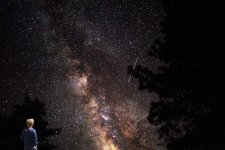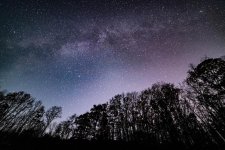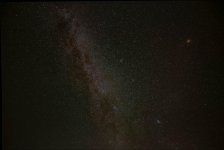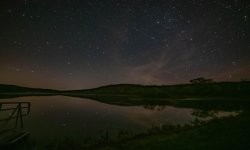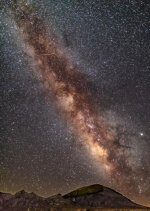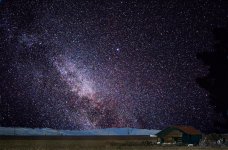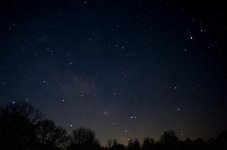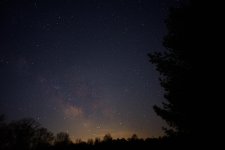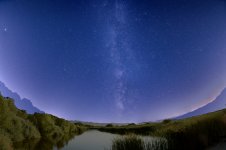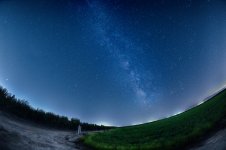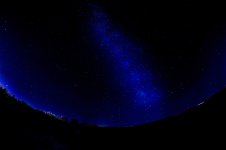You are using an out of date browser. It may not display this or other websites correctly.
You should upgrade or use an alternative browser.
You should upgrade or use an alternative browser.
Post your Milky Way shots
- Thread starter Dave_W
- Start date
Whiskeyman
Senior Member
View attachment 348544
Shot in a dark sky area in the central Nevada desert. Single shot.
D850 + AF 20mm f/1.8 D
The great basin has some of the darkest skies in the Continental US, and is a great place to shoot the Milky Way. You've done a very good job with it on this shot.
WM
View attachment 348544
Shot in a dark sky area in the central Nevada desert. Single shot.
D850 + AF 20mm f/1.8 D
Welcome!
Please feel free to introduce yourself here - https://nikonites.com/new-member-introductions/
TwistedThrottle
Senior Member
Roscoe Primrose
Senior Member
BF Hammer
Senior Member
This one taken shooting in the direction of light pollution. Over the elevation rise on the lower right corner the Sun Prairie Corn Festival is going on with the Sunday night midget car racing right then. It was an experiment for the location, I have a December photo in mind of the Orion segment of the sky rising in the east overlooking the lake that should be frozen and snow covered then. Want to know how much nebula I might be able to pull out of the scene. Milky Way was completely invisible to the naked eye here.
Nikon Z5, Carl Ziess 15mm f/2.8 Distagon, 5-sec sub-exposures, f/2.8, ISO 1600. 23 exposures. Foreground is single separate 25 second exposure. Stacked with Sequator, further refined with RawTherapee and GIMP.
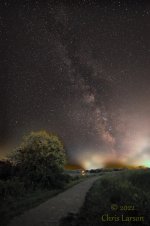
Nikon Z5, Carl Ziess 15mm f/2.8 Distagon, 5-sec sub-exposures, f/2.8, ISO 1600. 23 exposures. Foreground is single separate 25 second exposure. Stacked with Sequator, further refined with RawTherapee and GIMP.

blackstar
Senior Member
... Milky Way was completely invisible to the naked eye here.
Nikon Z5, Carl Ziess 15mm f/2.8 Distagon, 5-sec sub-exposures, f/2.8, ISO 1600. 23 exposures. Foreground is single separate 25 second exposure. Stacked with Sequator, further refined with RawTherapee and GIMP.
What is the cause that the MW was completely invisible? light pollution? sky condition? How did you locate the position for the shots?
Your total exposure was about 2'. How do you think of taking 20" or 25" single exposure could accomplish? Appreciate your sharing experience.
BF Hammer
Senior Member
What is the cause that the MW was completely invisible? light pollution? sky condition? How did you locate the position for the shots?
Your total exposure was about 2'. How do you think of taking 20" or 25" single exposure could accomplish? Appreciate your sharing experience.
This is a marsh and lake on the edge of my hometown. Viewing over the lake to the east and southeast there is minor light pollution, but south and west is where the city is, so light polluted. The Milky Way on that date at the pre-midnight time frame is almost due south. That is from looking in Stellarium. Google Earth Pro (app, not the website) allows you to enter ground view pretty much anywhere on or off-street, and you can change the skies to any date-time. That can give a decent approximation of where to set up and look. The star constellations help more. Taking high-ISO long exposure test shots pinpoint the Milky Way.
A single 25 second exposure is not enough in this condition. Light pollutions blows out the exposure for starters. The better solution is to increase the exposure time with stacking sub-exposures. Also at 15mm like I shot at, 25 seconds is close to a maximum number as star trails will start to be visible. 15 seconds has been a reliable number in darker skies for me.
I did take 25 second exposures, and I used a single one of those to overlay the foreground part of the image. I can adjust the color balance and brighten it up to taste without affect in the stars that way. And I can stretch the stacked star/Milky Way image to maximize it's visibility in the final product.
Bikerbrent
Senior Member
Hay blackstar! The first Milky Way shot is pretty good! The second Milky Way shot is a bit dark!
blackstar
Senior Member
... The second Milky Way shot is a bit dark!
Yeah, I know. It's the overall effect of the multi-process I tried.
BF Hammer
Senior Member
Yeah, I know. It's the overall effect of the multi-process I tried.
I presume the Z6 operates the same as my Z5 in that the interval timer feature will not work with manual mode. If you used a remote shutter release (ie: use the Snapbridge app) you could just keep snapping photos every 20 seconds and try to make a series of 80-100 images. With that many photos to use in a astro-stacking program you would have a Milky Way with all the details of the nebulae. And you can still layer a long-exposure on top and mask it for showing the foreground subject only.

